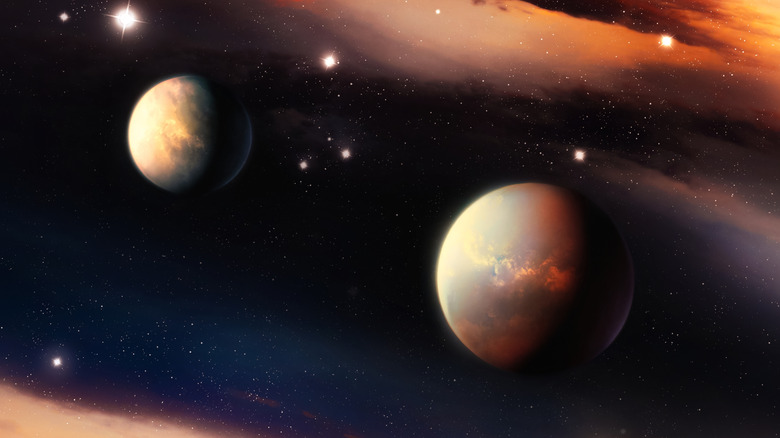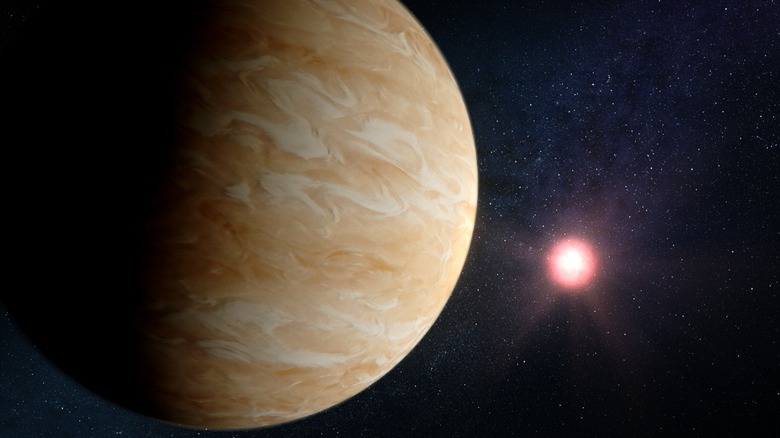The Bizarre Planet Close To Our Solar System That Keeps Baffling Scientists
Based on what NASA stands for and what the organization actually does, it's no surprise that it periodically discovers new objects in our solar system and beyond. Sometimes, though, the scientists come across something that baffles them. The exoplanet GJ 1214 b, also called Gliese 1214 b, is one for which they've been having trouble getting a solid understanding, despite numerous studies over the years, because of its thick atmosphere and concealing haze.
GJ 1214 b was first spotted in 2009 by the MEarth Project led by David Charbonneau of the Center for Astrophysics (CfA), the details of which were published in Nature. The researchers believed it to be a super-Earth with a thick atmosphere, a hot surface, and a water-ice interior. Using NASA's Hubble Space Telescope, CfA scientist Jacob Bean and his team reported in 2010 that the atmosphere was mainly composed of water, though they couldn't be certain because of a haze enshrouding the planet. Meanwhile, a pair of studies published in 2011 suspected the planet has a metal-rich atmosphere. Then, a study published in The Astrophysical Journal in 2012 found that the atmosphere is mostly dense water vapor and hypothesized that the planet is made up of more water but less rock than Earth.
In 2013, Japanese astronomers reported a thick, steamy atmosphere on GJ 1214 b and speculated that, unlike other known planets, the water content in the lower atmosphere is ionic or a plasma rather than a liquid, solid, or vapor — perhaps because temperatures are estimated to reach up to 540 degrees Fahrenheit on the planet. However, CfA astronomers observed the clouds of GJ 1214 b using the Hubble Space Telescope and reported in early 2014 no carbon dioxide, nitrogen, or water was detected with near-infrared wavelengths. Overall, the data collected have been inconsistent.
Researchers get closer to GJ 1214 b with the JWST
Scientists continued to study GJ 1214 b after 2014, and — punctuating the confusion — started referring to the planet as a sub-Neptune more often than a super-Earth. Then, in 2021, NASA launched its James Webb Space Telescope (JWST), which not only allowed the discovery of water on Pluto's moon Charon, it has been useful in uncovering new details about the exoplanet.
In 2023, a couple of studies published in Nature and The Astrophysical Journal confirmed that metals in the exoplanet's atmosphere make it highly reflective. The infrared capabilities of the JWST have allowed scientists to pierce the veil of haze and thick clouds around the exoplanet. Using heat maps, they found evidence of water in the form of a gaseous vapor, but since it looks similar to methane, the results could be that gas instead or a mixture of both. The studies also suggest that GJ 1214 b may have formed away from its star and gravitated toward it over time. Meanwhile, the planet was included in the exoplanet-naming process overseen by the International Astronomical Union and named Enaiposha, which is a Maasai word for "large body of water," even though the evidence for such water has been inconclusive so far.
The most puzzling findings, though, came in two studies published in 2024 in The Astrophysical Journal Letters. Together, these companion papers suggest that Enaiposha actually has a carbon dioxide–dominated atmosphere. If confirmed, that would make Enaiposha a rare planet unlike anything in our solar system and a completely new type of planet — a super-Venus. More consistent, concrete evidence is needed to decipher this bizarre planet.

